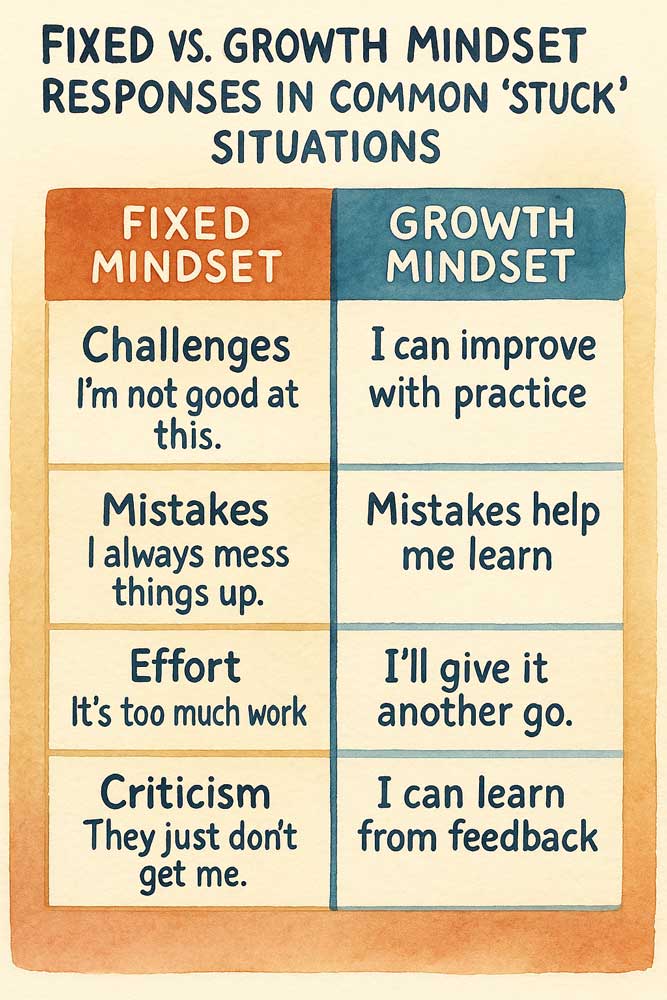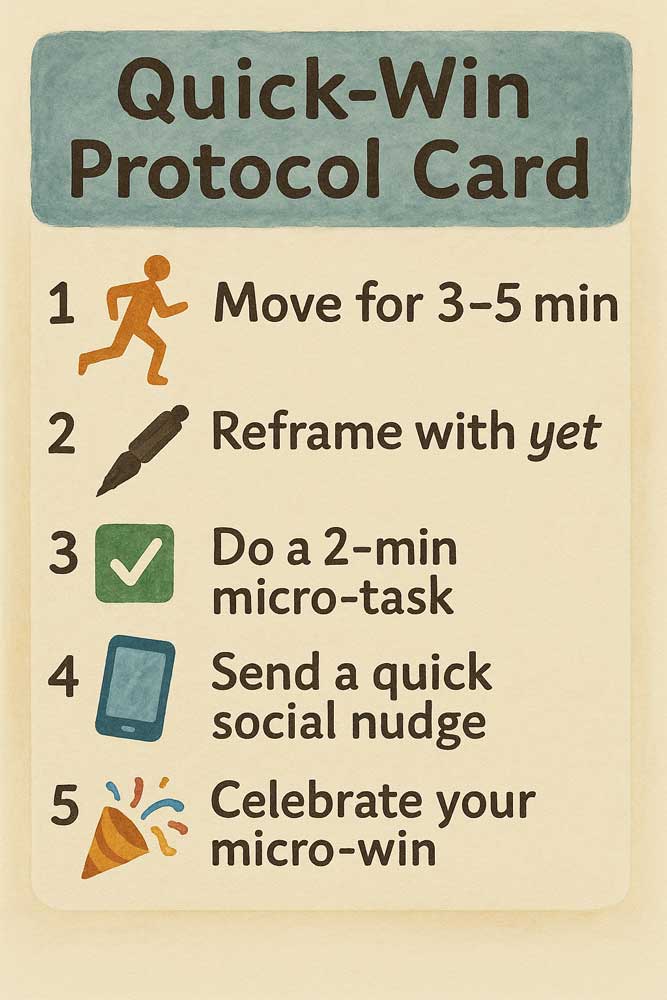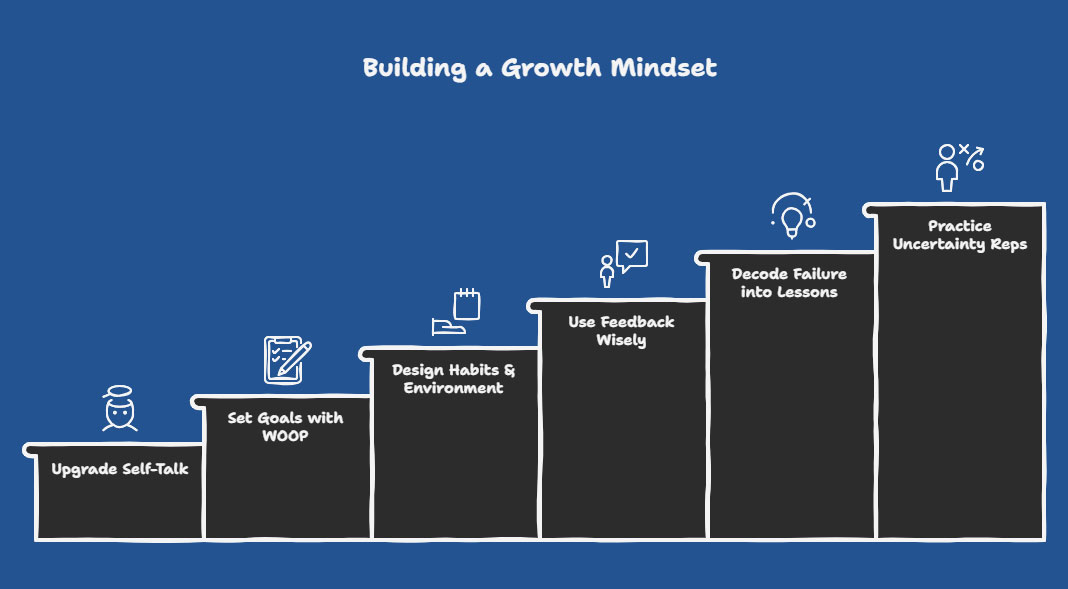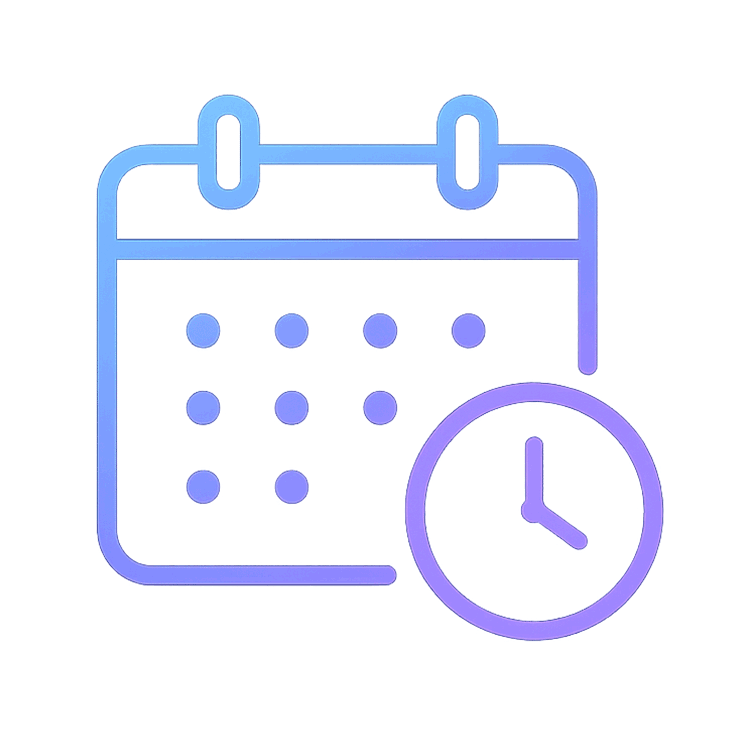You’re not broken—you’re just stuck. This guide blends science and simple tools to help you restart momentum today, then build a durable growth mindset that lasts. (Research pack synthesized for this article. )
The 90-Second Check — Are You in a Rut, Burnout, or Something Deeper?
Quick self-assessment (answer yes/no):
- Have you felt flat, “blah,” or unmotivated most days for several weeks, but you’re still functioning? → could be languishing (not a clinical diagnosis, but a low-wellbeing state) (Keyes 2002: PubMed).
- Do you feel drained by work, cynical, and less effective specifically about your job? → consider burnout (ICD-11 recognizes burnout as an occupational phenomenon) (World Health Organization).
- For 2+ weeks, have you had low mood or lost interest in almost everything plus changes in sleep/appetite, concentration, or thoughts of death? → depression signs; seek help (National Institute of Mental Health).
When to seek professional help (now): suicidal thoughts; inability to function at work/home; persistent hopelessness; symptoms ≥2 weeks; or if you’re unsure.

Growth vs. Fixed Mindset — What It Really Means for Adults
Growth mindset ≠ “just try harder.”
It’s the belief that you (and your skills) can change with effective strategies, feedback, and effort. Adult-oriented summaries from Stanford emphasize strategy and environment, not blind grind (Teaching Commons).
The power of “yet.”
Swap “I can’t do this” → “I can’t do this yet,” then identify the next skill/strategy to try (TED).
What the evidence says.
A 2023 Psychological Bulletin meta-analysis reports small-to-moderate benefits of mindset interventions with high variability—effects improve when paired with concrete strategies and supportive contexts
Takeaway: adopt the belief that change is possible—and pair it with tactics (planning tools, feedback loops, and environment design).
The Science of Feeling Stuck (in 5 quick ideas)
Languishing
It’s the “meh” middle between flourishing and depression—low motivation, not clinical illness.
Avoidance loops
They keep you stuck; behavioral activation breaks the loop by scheduling small, mastery/pleasure activities even when motivation is low.
Novelty boosts engagement.
Exposure to something new can nudge dopamine systems and memory—think a new route, café, or task.
Uncertainty tolerance
is trainable; graded “uncertainty exposure” reduces avoidance and builds flexibility.
Self-compassion fuels persistence.
Meta-analyses show self-compassion interventions reduce stress, anxiety, and depression in adults.

The 10–30 Minute Quick-Win Protocol (use this today)
When you feel frozen, run this short sequence once. Finish it even if motivation is 0/10.
Move (3–5 minutes).
Light movement (stairs, brisk walk, jumping jacks) raises arousal and primes action. Set a timer. (No gym needed.)
Reframe with “yet” (60 seconds).
Write the stuck thought, add yet, then add one strategy you’ll try next (“I don’t know where to start yet—I’ll list three options and pick one.”)
Micro-task (2 minute s).
Do the first 120 seconds of the task: open the doc and type a title; draft the first email line; wash one dish. This is behavioral activation—action before motivation (Greater Manchester Mental Health NHS FT).
Social nudge (1 minute).
Text: “Starting X for 10 min. I’ll update you after.” Externalizing intentions increases follow-through (Tandfonline).
Micro-celebration (30 seconds).
Mark a ✅, say out loud what you did, and schedule the next tiny step. Small rewards reinforce approach behavior.
Save this as a phone note titled “Quick-Win Protocol.”

The 7-Day Unstick Sprint
Think of this as a reset week. Each day you’ll do one small but powerful action that nudges your brain from “stuck” to “growing.” Keep it simple, follow the plan, and by Day 7 you’ll feel lighter and more capable.
Day 1: Name Your Stuck Script (and Add “Yet”)
- What to do: Write down the thought that loops in your head when you feel stuck (e.g., “I’ll never finish this project”).
- Now reframe it: Add the word “yet” and a next-step strategy → “I haven’t finished this project yet—today I’ll draft the outline.”
- Why it works: Shifting language from fixed to growth opens your brain to problem-solving.
Day 2: Create a WOOP Plan
- WOOP = Wish, Outcome, Obstacle, Plan.
- Wish: Something meaningful but realistic.
- Outcome: The best result if it happens.
- Obstacle: The inner barrier (procrastination, fear).
- Plan: An if–then statement to overcome it.
Example:
- Wish: Exercise 3x this week.
- Outcome: Feel stronger, more energetic.
- Obstacle: Feeling tired after work.
- Plan: If I feel tired after work, then I’ll put on my sneakers and just walk for 5 minutes.
Why it works: WOOP has strong research support for building follow-through in adults (WOOP research hub: https://woopmylife.org/en/science).
Day 3: Do One Safe-to-Fail Experiment
- What to do: Pick something new that feels slightly uncomfortable but not overwhelming (e.g., speaking up in a meeting, trying a new hobby, sending a pitch).
- Why it works: This builds “uncertainty tolerance”—a proven way to break avoidance and expand your comfort zone.
Day 4: Redesign Your Environment (Friction Map)
- Step 1: List one positive action you want to do more of and one avoidance loop you want to do less of.
- Step 2: Adjust friction.
- Make good habits easier (leave your journal open on your desk).
- Make avoidance harder (delete the distracting app).
- Why it works: Environment design removes willpower from the equation—habits become automatic.
Day 5: Seek Feedback (and Actually Use It)
- What to do: Ask one person you trust: “What’s one thing I could improve on, and one thing I’m doing well?”
- Step 2: Apply just one suggestion right away.
- Why it works: Growth mindset thrives on feedback—it’s not judgment, it’s data you can use to grow.
Day 6: Practice a 2-Minute Failure Debrief
- What to do: After any setback, write three quick lines:
- What happened?
- What did I try?
- What will I try next?
- Why it works: This rewires “failure = I’m bad” into “failure = feedback,” a hallmark of growth mindset.
Day 7: Reflect and Pick Your Next Micro-Challenge
- What to do: Look back on the week. Ask: Which day’s activity helped me the most?
- Step 2: Set one micro-challenge for the next 7 days (e.g., run the Quick-Win Protocol every morning, or do a WOOP daily).
- Why it works: Reflection locks in learning. Micro-challenges prevent relapse into “stuck mode.”
📌 Pro Tip:
Don’t aim for perfect streaks. If you miss a day, restart the sprint. Each restart is a sign of resilience, not failure.

Six Growth-Mindset Levers to Build Into Daily Life
Growth mindset isn’t a one-time switch—it’s something you strengthen daily, like a muscle. Here are six levers you can actively use to stay unstuck and moving forward.
-
Beliefs & Language: Upgrade Your Self-Talk
- Swap fixed for growth phrases.
- Fixed: “I’m terrible at this.”
- Growth: “I haven’t mastered this yet—what strategy can I try?”
- Why it works: Language shapes mindset. Research shows adding “yet” encourages persistence and strategy-seeking.
-
Goals That Stick (WOOP & Implementation Intentions)
- WOOP: Wish, Outcome, Obstacle, Plan.
- Implementation Intentions: Create if–then rules. Example: If it’s 7 PM, then I’ll put on my shoes and walk for 10 minutes.
- Why it works: These tools consistently improve follow-through in adults, according to meta-analyses.
-
Habits & Environment Design
- Make good habits frictionless. Place your journal on your pillow so you can’t miss it.
- Make avoidance harder. Log out of social media each night.
- Why it works: Behavior science shows environment tweaks beat willpower.
-
Feedback You’ll Actually Use
- Seek feedback actively: Ask, “What’s one thing I could do better?”
- Filter feedback wisely: Keep what’s constructive, discard what’s unhelpful.
- Why it works: Growth mindset thrives on feedback loops—studies show performance improves when feedback is paired with strategy adjustments.
-
Decode Failure into Lessons
- Try the 2-minute debrief:
- What happened?
- What did I try?
- What will I try next?
- Why it works: Meta-analyses confirm growth-mindset interventions work best when they normalize mistakes as learning opportunities.
-
Practice “Uncertainty Reps”
- Pick a small challenge that’s mildly uncomfortable (e.g., trying a new café alone, asking a question in a meeting).
- Repeat weekly. Over time, your brain rewires to tolerate uncertainty instead of avoiding it.
- Why it works: Research shows graded exposure to uncertainty builds flexibility and resilience.
✅ Takeaway: These six levers—self-talk, goals, habits, feedback, failure debriefs, and uncertainty reps—are the daily “weights” that keep your growth mindset strong. The more you practice, the more natural they become.

Troubleshooting When It Isn’t Working
Even with the best tools, there will be days—or weeks—when progress stalls. That doesn’t mean you’re failing; it means you’re human. Here’s how to troubleshoot the three most common growth-mindset roadblocks.
- Plateaus: “I’m doing the work, but nothing’s changing.”
- Reframe the plateau: Instead of “I’m stuck,” try: “This is consolidation time—my brain is wiring the skill underneath.”
- Add novelty: Research shows novelty boosts dopamine and re-engages motivation.
- Try micro-progress tracking: Write down tiny wins daily (e.g., “sent one email,” “read two pages”). Small evidence builds confidence.
- Perfectionism: “If it isn’t perfect, why try?”
- Shift focus to progress, not outcome. Ask: “What’s 1% better than yesterday?”
- Use the “good enough” rule: Stop at 80% complete and move on—perfection is often procrastination in disguise.
- Science check: Self-compassion (being kind to yourself after mistakes) lowers perfectionism and boosts persistence.
- Relapse: “I was doing well, then I fell back into old habits.”
- Expect relapse. It’s part of every change process, not a personal flaw.
- Run a 2-minute after-action review: What triggered the slip? What’s one tweak for next time?
- Set up a “restart ritual.” Example: every Monday, review your WOOP or Quick-Win Protocol.
- Why it works: Relapse prevention is strongest when you normalize slips and plan recovery steps.
✅ Takeaway: When it feels like nothing is working, don’t double down on shame. Instead, try one of these adjustments: reframe the plateau, embrace imperfection, or create a restart ritual. Every stumble can be turned into data for growth.
When to Seek Professional Help
A growth mindset is powerful—but it’s not a substitute for medical or therapeutic care. Sometimes what feels like “just a rut” may actually be burnout or depression. Knowing when to get help is part of a growth mindset too.
Red Flags That Suggest It’s More Than a Rut
Seek professional support if you notice:
- Persistent low mood or loss of interest for 2+ weeks.
- Major changes in sleep, appetite, or concentration.
- Intense feelings of hopelessness or worthlessness.
- Thoughts of death or self-harm.
- Daily functioning at work, school, or home has become very difficult.
Burnout vs. Depression
- Burnout → emotional exhaustion, cynicism, reduced performance, usually tied to work. Recognized by WHO as an occupational phenomenon.
- Depression → affects multiple areas of life, not just work. Needs evaluation by a mental health professional.
What to Expect When Seeking Help
- Primary care doctor: can do a first check and refer you.
- Therapist/psychologist: helps you explore patterns, build coping tools, and process underlying issues.
- Psychiatrist: can evaluate if medication is appropriate.
Accessible Resources (Global)
- United States:
- United Kingdom:
- Canada:
- Global:
✅ Takeaway: A growth mindset includes recognizing when self-help tools aren’t enough. Seeking support isn’t weakness—it’s wisdom.
Why do I feel stuck in life even when things seem fine?
Feeling stuck often comes from being caught in routines, lacking clear goals, or holding onto limiting beliefs. Even if life looks “fine” externally, your inner drive may be blocked by fear of failure, perfectionism, or lack of new challenges. Shifting to a growth mindset helps you reframe obstacles as opportunities for learning.
How do I know if I’m in a rut or just tired?
If you’re simply tired, rest and recovery usually restore your energy. Being “stuck in a rut” feels different—it’s ongoing, with loss of motivation, sense of purpose, and excitement. If daily tasks feel empty or repetitive for weeks, you may be in a rut.
What is the fastest way to get unstuck?
Quick wins help break inertia. Try moving for 3–5 minutes, reframing negative thoughts with “yet,” or completing a 2-minute micro-task. These small shifts signal progress to your brain and build momentum toward bigger changes.
How does a growth mindset help when I feel stuck?
A fixed mindset sees obstacles as signs of personal inadequacy. A growth mindset reframes them as temporary and solvable. For example, instead of saying “I can’t do this,” you say “I can’t do this yet.” This subtle shift keeps you open to learning, experimenting, and finding solutions.
Can journaling really help me get unstuck?
Yes. Journaling externalizes your thoughts, turning vague worries into concrete words. Prompts like “What’s one thing I can do today to move forward?” or “What am I avoiding and why?” help you gain clarity, track progress, and spot hidden growth opportunities.
How long does it take to get out of a rut?
There’s no universal timeline. Some people feel relief after small quick wins in a day or two, while deeper ruts linked to career, relationships, or purpose may take weeks of consistent effort. The key is persistence with micro-actions and self-compassion during setbacks.
What if I try but keep falling back into old habits?
That’s normal. Habits have friction—good ones can be made easier (e.g., leaving your workout clothes out), and unhelpful ones harder (e.g., putting social media apps in folders). Treat setbacks as “data” for improvement, not proof of failure. Reflect, adjust, and try again.
When should I seek professional help?
If feeling stuck lasts for months, impacts your mental health, or leads to depression or anxiety, professional support from a therapist or coach can help you explore deeper causes and build tailored strategies.








